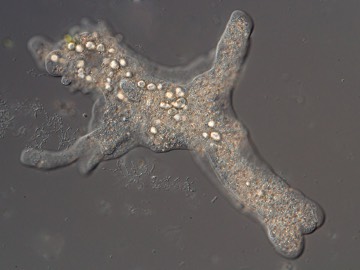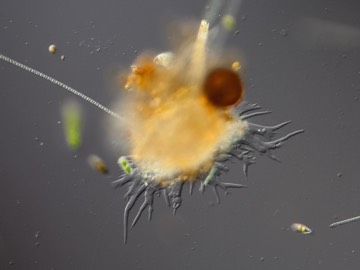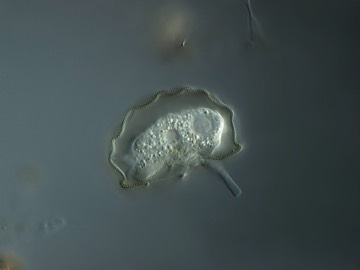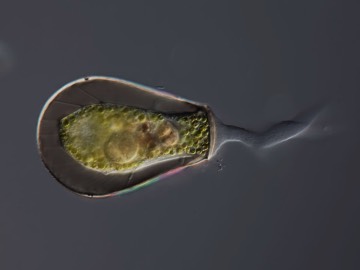Tubulinea Smirnov et al. 2005
Tubular, sub-cylindrical pseudopodia or capable of altering the locomotive form from a flattened, expanded one to a sub-cylindrical one. Monoaxial flow of the cytoplasm in every pseudopodium or in the entire cell.
Tubular, sub-cylindrical pseudopodia or capable of altering the locomotive form from a flattened, expanded one to a sub-cylindrical one. Monoaxial flow of the cytoplasm in every pseudopodium or in the entire cell.
1. Euamoebida Lepsi 1960, emend. Smirnov et al. 2011
Naked with subcylindrical pseudopodia in locomotion (or the entire cell is monopodial and subcylindrical); without alteration of the locomotive form to a flattened expanded and branched one; without adhesive uroid; glycocalyx amorphous, filamentous or consisting of prismatic, cup-shaped structures.
Including: Amoeba, Chaos, Hartmannella, Parachaos, Polychaos.
Gallery
Including: Amoeba, Chaos, Hartmannella, Parachaos, Polychaos.
Gallery
2. Leptomyxida Pussard and Pons 1976, emend. Page 1987
Naked with locomotive form altering from a flattened expanded or reticulate one, when slowly moving, to a subcylindrical monopodial one when in rapid movement or under specific conditions; adhesive uroid.
Including: Rhizamoeba.
Gallery
Including: Rhizamoeba.
Gallery
3. Arcellinida Kent 1880
Testate, inside an organic or mineral extracellular test of either self-secreted elements (calcareous, siliceous, or chitinoid) or recycled mineral or diatom particles bound together, with a single main opening.
3.1. Arcellina Haeckel 1894
Test rigid or more or less flexible, chitinoid or membranous, sometimes with attached debris; without scales or plates; pseudopodia digitate, finely granular.
Including: Amphizonella, Arcella, Microchlamys, Microcorycia, Pyxidicula, Spumochlamys.
Gallery
Including: Amphizonella, Arcella, Microchlamys, Microcorycia, Pyxidicula, Spumochlamys.
Gallery
3.2. Difflugina Meisterfeld 2002
Test either completely chitinoid or comprising mineral particles, diatom frustules, or recycled scales or plates (often from Euglyphida), or composed of siliceous, calcite, or chitinoid self-secreted plates held together by an organic cement; granular, digitate pseudopodia.
Including: Centropyxis, Difflugia, Hyalosphenia, Lesquereusia, Nebela, Netzelia, Padaungiella, Quadrulella.
Gallery
Including: Centropyxis, Difflugia, Hyalosphenia, Lesquereusia, Nebela, Netzelia, Padaungiella, Quadrulella.
Gallery



